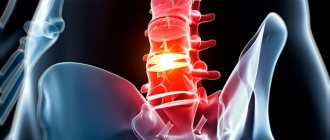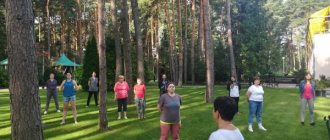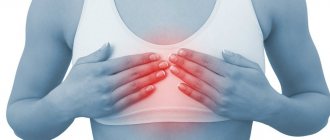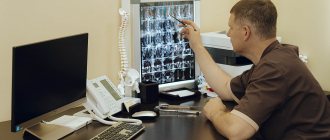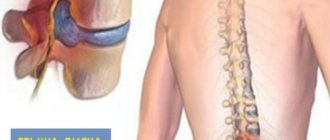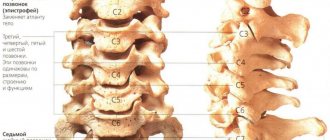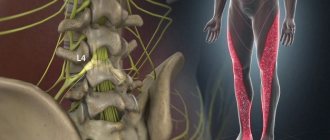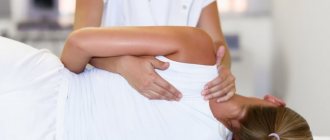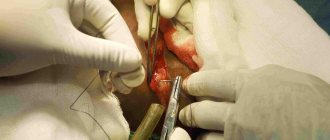Lumbar osteochondrosis is a common disease of the musculoskeletal system. It is characterized by the development of degenerative-dystrophic processes in joint and bone tissue. Lumbar osteochondrosis implies that tissue damage occurred specifically in the lumbar and sacral area, so the patient will experience corresponding symptoms. Osteochondrosis of the lumbosacral spine causes significant discomfort to a person. It negatively affects the condition of not only the back, but also the lower extremities. About how to treat lumbar osteochondrosis, you need to check with a specialist - a neurologist or traumatologist. You should not treat this complex disease on your own or on the advice of relatives and friends. Self-medication can only aggravate the process and cause even more harm to the spine.
In Moscow, high-quality treatment for osteochondrosis is carried out at the Yusupov Hospital. The best specialists in Moscow work here, who specialize in eliminating this problem.
Osteochondrosis of the lumbar spine: causes
Osteochondrosis of the lumbosacral region is considered to be a disease of older people. However, recently lumbosacral osteochondrosis is increasingly being diagnosed in young people (25-30 years old). This is due to the fact that many young people lead a sedentary lifestyle and spend a lot of time at the computer. An additional factor is the constant stress that a young person experiences in the modern world. Combined with poor nutrition and the predominance of fast food, this leads to a deterioration in the condition of not only the spine, but also the entire body.
Lumbar osteochondrosis of the spine is a type of pathology that is localized in the lumbar region. This is one of the most common types of osteochondrosis. The exact causes of the development of the disease are not thoroughly known, but there are provoking factors, the presence of which significantly increases the likelihood of developing osteochondrosis. These include:
- sedentary work;
- curvature of posture;
- sedentary lifestyle;
- excessive stress on the spine (professional sports, regular weight lifting, heavy physical labor);
- overweight;
- back injuries;
- age (over the years, spinal tissues undergo natural processes of aging and thinning);
- inflammatory diseases in the joints (arthritis, arthrosis, scoliosis, etc.);
- diseases accompanied by metabolic disorders;
- Unhealthy Lifestyle;
- hereditary predisposition.
Osteochondrosis of the lumbar spine: symptoms
At an early stage, it is quite difficult to identify lumbosacral osteochondrosis. Symptoms and treatment of the disease will depend on the degree of damage to the spinal tissue. Signs of osteochondrosis of the lumbar spine appear gradually, starting with minor discomfort and, in advanced cases, the appearance of acute pain. Treatment of lumbar osteochondrosis cannot be delayed. As the disease progresses, the symptoms will only intensify, causing the person more discomfort. In a severe acute period, it is painful for a person to even stand up, so it is necessary to immediately treat lumbar osteochondrosis. The symptoms of the disease are as follows:
- pain in osteochondrosis of the lumbar region is the most striking sign of pathology. They can grow gradually, intensifying during movements (bending or lifting weights). As the disease progresses, the intensity of the pain will increase, and during an attack of acute osteochondrosis it will be unbearable;
- impaired lumbar mobility. Pathological processes in the spine affect the ability to make any movements in this department: it is difficult for a person to bend over, turn to the sides, or sit with a straight back;
- dysfunction of the lower extremities. There is a disturbance in gait, numbness, tingling, a feeling of “pins and needles”, and muscle weakness occur in the legs;
- pallor of the skin is noted, which is associated with impaired blood supply to the affected area;
- sexual dysfunction (possible in severe cases).
Osteochondrosis of the lumbosacral spine: symptoms and degrees
There are four degrees by which lumbar osteochondrosis develops. Symptoms and treatment directly depend on the degree of osteochondrosis: the intensity of the manifestations of the disease increases with the progression of the degenerative process, which is important to consider when drawing up a course of therapy.
Intervertebral osteochondrosis of the lumbar region is classified as follows:
- Osteochondrosis of the 1st degree of the lumbar region is manifested by minor discomfort in the lumbar region. They can occur after intense physical exertion or a long working day. A person may feel pain in the back or buttock area, as well as tingling in the lower back;
- Osteochondrosis of the 2nd degree of the lumbar region is felt more pronounced. At grade 2, destruction of the fibrous ring of the intervertebral disc begins. The distance between the vertebrae narrows or stretches, and the intervertebral disc begins to extend beyond the vertebrae. Compression of the nerve roots of the spine occurs, which results in significant pain in the lower back, which is reflected in the area of the buttock, thigh and lower leg. The person may also feel a burning or cold sensation in the lower back;
- Osteochondrosis of the 3rd degree of the lumbar region is characterized by the final destruction of the fibrous ring. The contents of the intervertebral disc come out - a hernia is formed. The nerve roots are compressed more strongly, an inflammatory process occurs, which is accompanied by severe constant pain in the lumbar region;
- Osteochondrosis of the 4th degree of the lumbar region is accompanied by complete atrophy of cartilage and pathological proliferation of the vertebrae. This is a compensatory reaction of the body to a violation of the intervertebral disc. At this stage, the pain usually goes away, however, this indicator does not indicate an improvement in the condition. The proliferation of vertebrae significantly impairs the mobility of the spine and can lead to disability.
Lumbar osteochondrosis: symptoms and treatment of exacerbation
Exacerbation of lumbar osteochondrosis can be triggered by sudden movement, lifting weights, or hypothermia. Acute pain in lumbar osteochondrosis can increase gradually or appear suddenly. Most often, exacerbation of lumbar osteochondrosis is accompanied by acute severe pain. During an attack, muscle spasm occurs in the lumbar and thoracic spine, which prevents the movement of the back to prevent increased pain. Pain in the acute period spreads to the buttocks and leg, which are connected by nerve fibers to the affected area of the spine. A person is forced to take a certain position and not change it (usually a horizontal position with the affected leg bent). Even minor movements, such as coughing, can cause another attack of pain.
An exacerbation of lumbar osteochondrosis, treatment of which must be started immediately, can last several days or weeks (depending on how quickly adequate therapy was started). At the Yusupov Hospital, treatment of acute osteochondrosis is performed immediately after the patient’s treatment. The hospital's emergency department is open 24 hours a day, so the patient can receive help at any time. To relieve acute pain, blockades are performed - the introduction of an analgesic into the affected area, which contributes to a significant improvement in the condition. After eliminating the acute period, the main course of treatment begins.
Diagnostics
If you experience back pain, you should consult a neurologist. The history is followed by an examination of the patient, during which active and passive range of motion, muscle tone, limb strength, reflexes and sensation are assessed6.
The following instrumental diagnostic methods are used:6
- magnetic resonance imaging (MRI is a method for studying the layer-by-layer structure using magnetic fields);
- computed tomography (CT is a method for studying the layer-by-layer structure using x-rays);
- in rare cases, electromyography (a method for studying electrical potentials arising in muscles);
- functional spondylography (x-ray examination of any part of the spine).
You may additionally need to consult a urologist, gynecologist and proctologist1.
Lumbar osteochondrosis: symptoms and diagnosis
Treatment of lumbosacral osteochondrosis begins with diagnosis. It is necessary to find out whether this is true osteochondrosis, and what is the extent of tissue damage. Osteochondrosis of the lower back is detected using radiography. The image will clearly show the condition of the intervertebral disc and vertebrae. The doctor clarifies the location of the lesion and assesses the degree of development of the disease. If necessary, an additional MRI or CT may be prescribed to clarify the details.
Diagnosis of osteochondrosis is carried out at the diagnostic center of the Yusupov Hospital, which has everything necessary for an accurate diagnosis. Experienced staff uses modern equipment, which allows them to quickly and correctly identify the patient’s illness. How neurologists and physiotherapists will treat lumbar osteochondrosis will depend on the diagnostic results.
Proper nutrition for osteochondrosis
To prevent the problem from developing and help eliminate it, the clinic doctor develops an individual diet. Basic principles of proper nutrition for osteochondrosis:
- increase the amount of fresh fruits in the diet;
- eat more greens and vegetables (tomatoes, onions, carrots, cabbage);
- include dairy products in the area;
- drink only purified and still water;
- consume more foods containing calcium (sesame, almonds);
- increase the consumption of wheat, eggs, barley, which contain a lot of proteins;
- eat more seafood.
In addition, it is necessary to maintain the level of vitamins A, B and D in the body.
At the same time, it is necessary to reduce consumption or completely abandon:
- spicy foods and foods high in salt;
- strong coffee and tea;
- alcohol, including low-alcohol drinks (beer);
- fried, dried and smoked products (fish, meat);
- products with artificial inclusions (GMO).
Proper nutrition will protect intervertebral discs from premature damage and reduce the risk of their displacement.
Lumbar osteochondrosis: symptoms and treatment with medications
After diagnosis, each patient is interested in the question “How to cure lumbar osteochondrosis?” Treatment of osteochondrosis of the lumbosacral region will be complex and consist of medication and physiotherapy. At the Yusupov Hospital, each component of treatment is determined by the appropriate specialist based on the individual characteristics of the patient. Symptoms and signs of osteochondrosis of the lumbosacral spine allow you to choose the most optimal therapy that will be most effective.
Drug treatment of lumbar osteochondrosis includes several types of drugs, each of which performs its own function:
- non-steroidal anti-inflammatory drugs: eliminate pain and inflammation;
- painkillers: relieve severe pain that the previous group of drugs cannot cope with;
- muscle relaxants: relieve muscle spasms;
- chondroprotectors: stop the degenerative process, promote regeneration of spinal tissue;
- vitamin complexes: normalize nerve conduction, improve the body’s protective properties.
All medications, their dosage and duration of use are determined strictly by the attending physician.
Literature:
- Biktimirov R.G., Kedrov A.V., Kiselev A.M., Kachkov I.A., Osteochondrosis of the spine - Almanac of Clinical Medicine - 2004. P.329,330,333,334, https://cyberleninka.ru/article/n/osteohondroz-pozvonochnika/viewer
- Human anatomy: textbook. -method. manual / M. V. Ulitko, I. M. Petrova, A. A. Yakimov; [under general ed. M. V. Ulitko]; Ministry of Science and Higher Education education Ros. Federation, Ural. federal n-t. - Ekaterinburg: Ural Publishing House. University, 2021. - 88 p. ISBN 978-5-7996-2447-7
- Oleynik A.D., Kovalev S.A. // Criteria for a comprehensive assessment of foci of lumbar osteochondrosis // Bulletin of the International Scientific Surgical Association - 2008 P. 84 https://cyberleninka.ru/article/n/kriterii-kompleksnoy-otsenki-ochagov-poyasnichnogo-osteohondroza/viewer
- Nikiforov A.S., Avakyan G.N., Mendel O.I., Modern approaches to the treatment of complications of spinal osteochondrosis - RMZh No. 26 from November 26, 2010 - P.1633 https://www.rmj.ru/articles/nevrologiya /Sovremennye_podhody_k_lecheniyu_osloghneniy_osteohondroza_pozvonochnika/
- Velichko T.I., Loskutov V.A., Loskutova I.V. // Exercise therapy and therapeutic swimming in orthopedics // 2014 -2.5 — Osteochondrosis https://monographies.ru/en/book/section?id=7270
- Gushcha A.O., Konovalov N.A., Dreval O.N., Grin A.A., Dzhindzhikhadze R.S., Arestov S.O., Dreval M.D., Kashcheev A.A., Vershinin A. V.V., Asyutin D.S., Korolishin V.S., Clinical guidelines for the diagnosis and treatment of herniated intervertebral discs of the lumbosacral spine. - 2014 - pp.4,7,8 https://www.mst.ru/information/manual/lumbar_disc_herniation.pdf
- Pilipovich A.A., Treatment and prevention of osteochondrosis - 2015. — S.1,17,18,19 https://cyberleninka.ru/article/n/lechenie-i-profilaktika-osteohondroza/viewer
- Rodichkin P.V., Shalamanov N.S. Pathophysiological rationale for complex therapy of intervertebral hernias -2012-P.32 https://www.vmeda.org/wp-content/uploads/2016/pdf/31-36.pdf
- Instructions for medical use of the drug Motrin ® tablets, Reg. number P N002874/01 ///o-motrin
- Buchakchiyskaya N.M., Maramukha V.I., Maramukha A.A., Maramukha I.V., Non-drug treatment of patients with neurological manifestations of osteochondrosis of the lumbar spine - Science of Life and Health - 2013. P.104 https://cyberleninka.ru/article/n/nemedicamentoznoe-lechenie-bolnyh-s-nevrologicheskimi-proyavleniyami-osteohondroza-poyasnichnogo-otdela-pozvonochnika-sovremennyy/viewer
- Therapeutic physical education for spinal osteochondrosis: textbook / O. V. Bezrukova, G. I. Bulnaeva; GBOU VPO IGMU of the Ministry of Health of Russia. – Irkutsk: IGMU, 2013. – 58 p.
- Frick et al. Efficacy and safety of naproxen sodium and ibuprofen for pain relief after oral surgery. Current Therapeutic Research. 1993;54(6):619-27.
- Clinical recommendations. Diagnosis and treatment of musculoskeletal (nonspecific) pain in the lower back. Russian Interregional Society for the Study of Pain. 2021
- Cochrane Database of Systematic Reviews. (2010.) “Advice to rest in bed versus advice to stay active for acute low-back pain and sciatica.” https://pubmed.ncbi.nlm.nih.gov/20556780/
- Svetoslav Nikolaev Stoev, Stanislav Radoslavov Gueоrguiev, Vasil Georgiev Madzharov, Hristina Viktorova Lebanova (2021). “Naproxen in Pain and Inflammation – A Review”, International Journal of Pharmaceutical and Phytopharmacological Research, 11(1), pp.142-148.
Osteochondrosis of the lumbar spine: treatment with physiotherapy methods
Treatment of lumbar osteochondrosis includes a course of physiotherapy. This is also an important component of treatment, like drug therapy. Some patients are interested in how to treat osteochondrosis of the lumbar spine without physical therapy. However, the disease cannot be eliminated using medications alone. Medicines will dull the pain, which will still return quite quickly.
At the Yusupov Hospital, physiotherapy for osteochondrosis is carried out in the rehabilitation department by qualified specialists. The patient is prescribed a course of rehabilitation taking into account his capabilities and needs. Physiotherapy includes:
- massage for osteochondrosis of the lumbar region;
- spinal stretch;
- physical therapy;
- reflexology (acupuncture);
- hardware methods of influence (electrophoresis, amplipulse, phonophoresis, etc.).
Only by using complex treatment can osteochondrosis be cured. Low back pain usually goes away within a few days after starting therapy (depending on the severity of the disease). However, this is not a reason to stop the course of treatment. To achieve a better result and avoid a rapid relapse of the pathology, you must complete the full course, which is compiled by specialists. Using effective treatment methods, doctors at the Yusupov Hospital achieve a significant improvement in the patient’s condition, which allows him to return to a full life.
You can make an appointment with neurologists, rehabilitation specialists, physiotherapists and other clinic specialists, find out information about the work of the diagnostic center and other questions of interest by calling the Yusupov Hospital.
Disease prevention
The best means of preventing osteochondrosis of the lumbar spine are daily gymnastics and a five-minute physical break at the workplace consisting of 6-8 basic exercises, preferably swimming in the pool. All bad habits are eliminated. Particular importance is attached to the choice of mattress. It must be orthopedic, rigid and hard. Meals should be balanced and include more protein foods. The exceptions are fatty foods and mushrooms. Salt consumption is kept to a minimum.
